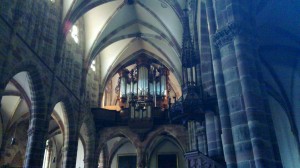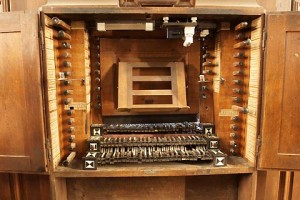Today I had good luck, as some organ player played the Dubois organ at the Peter and Paul abbey in Wissembourg.
Overview
The instrument was abandoned for about 40 years. Especially the console looked like there was no tomorrow. The following image was stolen from decouverte.orgue.free.fr[1]:
Fortunately the instrument is currently being restored. The inauguration concert is planned the May 20th, 2012. Individuals can support this project (french language) by a sponsorship of an individual key and stop between 20 and 200 €. Note that some stops contain more than one pipe a key. For example, the Cornet of the Grand Orgue starts at the c’ key (the lower keys do not support this stop) and contains 5 pipes a key, making the sponsorship of each note a bit more pricey.
Appearently most of the original parts of the instrument were still available, thus the restoration tried to reset the instrument to the original state as much as possible. It provides the typical sounds of french instruments of the 18th century.
Stops
Here’s the list of the current stops according to amis-orgue-dubois.com.
Positif
Range: C to c”’ (4 octaves)
Bourdon 8′
Flutte 8′
Prestant 4′
Flutte 4′
Nazard 2 2/3′
Doublette 2′
Tierce 1 3/5′
Larigot 1 1/3′
Fourniture (3 pipes per key)
Cromhorne 8′
Grand Orgue
Range: C to c”’ (4 octaves)
Flutte 16′
Bourdon 16′
Montre 8′
Bourdon 8′
Prestant 4′
Flutte 4′
Nazard 2 2/3′
Doublette 2′
Tierce 1 3/5′
Cornet (5 pipes per key)
Fourniture (4 pipes per key)
Cymbale (3 pipes per key)
Basson 16′
Tromette 8′
Voix Humaine 8′
Clairon 4′
Echo
Range: c’ to c”’ (2 octaves)
Bourdon 8′
Prestant 4′
Nazard 2 2/3′
Doublette 2′
Tierce 1 3/5′
Trompette 8′
Voix Humaine 8′
Pedale
Range: C to c’ (2 octaves)
Flutte 16′
Flutte 8′
Flutte 4′
Bombarde 16′
Trompette 8′
Clairon 4′
Remarks
There are a couple of things I find remarkable:
- Neither the Grand Orgue nor the Pedal is hosting a Principal 16′. Instead both provide a Flute 16′.
- Any of the three manuals contains a 2 2/3′ 5th (aka Nazard 2 2/3′) and a 1 3/5′ third (aka Tierce).
- The Pedal does not provide any aliquots.
- According to decouverte.orgue.free.fr the Echo consists of four octaves instead of two, omitting the C# (»sans le Do# grave«). However, the current list of pipes only lists two octaves. I have no clue whether this is achieved by some repetition respectively an octave coupler.
- It also mentiones three types of tremolo, soft, hard, and a dedicated tremolo for the Vox Humana (»Il y avait un Tremblant doux (“dans le vent”), un Tremblant fort (“à vent perdu”) et un Tremblant spécifique pour la Voix humaine.«). At least I can confirm the current instrument provides some tremolo, which I heard today.
Conclusion
It is great the instrument is being restored, and it was a great joy and pleasure listening to its flutes, thirds, and lingual stops this afternoon. Expecially the Cornet is my all time favorite stop.
All credits to the unknown player :) .
—
[1] decouverte.orgue.free.fr asks for attribution when reusing its contents: »Si vous recopiez des éléments de cette page pour des articles, plaquettes ou pages Web, citez vos sources. D’abord par simple honnêteté intellectuelle, mais aussi pour pouvoir pister d’éventuelles erreurs.«


